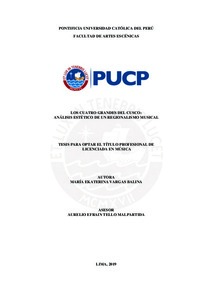| dc.contributor.advisor | Tello Malpartida, Aurelio Efrain | |
| dc.contributor.author | Vargas Balina, María Ekaterina | |
| dc.date.accessioned | 2019-08-27T16:09:13Z | es_ES |
| dc.date.available | 2019-08-27T16:09:13Z | es_ES |
| dc.date.created | 2019 | es_ES |
| dc.date.issued | 2019-08-27 | es_ES |
| dc.identifier.uri | http://hdl.handle.net/20.500.12404/14820 | |
| dc.description.abstract | Esta tesis estudia la obra de los Cuatro Grandes del Cusco –Juan de Dios Aguirre, Baltazar
Zegarra Pezo, Francisco González Gamara y Roberto Ojeda Campana– a través del análisis
semiológico tripartito (neutro, poiético y estésico) y el estudio del contexto sociocultural del Perú
y el Cusco de finales del siglo XIX y las primeras décadas del siglo XX, con la finalidad de
comprobar la hipótesis de que la incorporación de elementos tradicionales en la obra de estos
autores contribuyó a la creación de un movimiento de carácter nacionalista pero de alcance
regional. En el primer capítulo se sintetizó el panorama músical del Perú; y se profundizó en el
estudio de la realidad musical cusqueña de la primera década del siglo XX, los espacios que
compartieron estos músicos, sus biografías y su obra. En el segundo, se aplicó el análisis
paradigmático de Ruwet y la teoría de valores estéticos propuestos por Lewis Rowell para el
desarrollo del análisis semiológico | es_ES |
| dc.description.abstract | This thesis studies the work of the Great Four of Cusco –Juan de Dios Aguirre,
Baltazar Zegarra Pezo, Francisco González Gamara y Roberto Ojeda Campana– through tripartite
semiological analysis (neutral, poietic and esthesic) and the study of sociocultural context of Peru
and Cusco in the late nineteenth century and the first decades of the twentieth century, in order to
explore the hypothesis that the incorporation of traditional elements in the work of these
composers promoted the appearance of a nationalist movement in the region. In the first chapter,
the musical panorama in Peru is summarized, followed by an in-depth study of Cusco's musical
context during the first decade of the twentieth century, including the spaces shared by these
musicians, their biographies and their work. The second chapter presents semiological analyses
which were informed by Ruwet's paradigmatic analysis and Lewis Rowell's theory of aesthetic
values. | es_ES |
| dc.language.iso | spa | es_ES |
| dc.publisher | Pontificia Universidad Católica del Perú | es_ES |
| dc.rights | info:eu-repo/semantics/openAccess | es_ES |
| dc.rights.uri | http://creativecommons.org/licenses/by/2.5/pe/ | * |
| dc.subject | Música--Perú--Cuzco--Historia--Siglo XX | es_ES |
| dc.subject | Música andina | es_ES |
| dc.subject | Compositores peruanos | es_ES |
| dc.subject | Música para piano--Partituras | es_ES |
| dc.subject | Partituras | es_ES |
| dc.subject | Ojeda Campana, Roberto. Wifala | es_ES |
| dc.subject | Aguirre, Juan de Dios. Saqsaywaman | es_ES |
| dc.subject | Zegarra Pezo, Baltazar. Al despertar | es_ES |
| dc.subject | González Gamarra, Francisco. Paisaje Nº1 Noche de Luna en el Cusco | es_ES |
| dc.subject | Semiótica y arte | es_ES |
| dc.title | Los cuatro grandes del Cusco: análisis estético de un regionalismo musical | es_ES |
| dc.type | info:eu-repo/semantics/bachelorThesis | es_ES |
| thesis.degree.name | Licenciado en Música | es_ES |
| thesis.degree.level | Título Profesional | es_ES |
| thesis.degree.grantor | Pontificia Universidad Católica del Perú. Facultad de Artes Escénicas | es_ES |
| thesis.degree.discipline | Música | es_ES |
| renati.discipline | 215426 | es_ES |
| renati.level | https://purl.org/pe-repo/renati/level#tituloProfesional | es_ES |
| renati.type | http://purl.org/pe-repo/renati/type#tesis | es_ES |
| dc.publisher.country | PE | es_ES |
| dc.subject.ocde | https://purl.org/pe-repo/ocde/ford#6.04.04 | es_ES |






